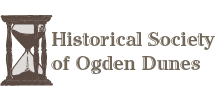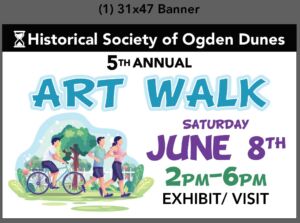The odyssey of the “Alpha Wreck” shipwreck, as it was described in 2007, near the east end of the shoreline in Ogden Dunes beach has periodically been the subject of articles, especially when the lake level is lower than normal. In 2007 the shipwreck was very visible and was investigated by a team, described as the Briggs team, and lead by Roger J. Barski. He and his team made the following presentation at the Historical Society.
Please note: It is extremely important that the Alpha Wreck not be disturbed in its resting place. Please do not remove any materials. Should components of the wreck become dislodged, please contact the Town of Ogden Dunes or the Historical Society these may be safely retrieved and viewed for future generations. We are working with the Indiana Department of Natural Resources and the National Park Service to preserve this historical artifact.
Following is a brief overview of the March 25, 2007 presentation by the Briggs Project Team sponsored by the Historical Society of Ogden Dunes:
Presentation Title
Devil’s Punchbowl – The Alpha Wreck Odyssey
Briggs Project
The project is named after a local Porter County Historian, William A. Briggs, who died in 1958. Briggs wrote many papers about a variety of topics throughout all of Indiana.
Underground Railroad Connection?
One article that Briggs wrote about in particular was a shipwreck near Burns Ditch that had a possible connection to the Underground Railroad movement. It is this article that caused the Briggs team to come together and research the story.
Briggs Team Members
R.J. Barski – Chicago, IL
John Loftus – Homewood, IL
Ruth Loftus – Homewood, IL
Jim Jarecki – Highland, IN
All four team members are certified scuba divers.
R. J. Barski is with the Nautical Archaeology Group
John and Ruth Loftus and Jim Jarecki are members of the Underwater Archaeological Society of Chicago.
Attached to the project is archaeologist and certified scuba diver:
Thomas J. Loebel, PhD, RPA – University of Illinois at Chicago
Bob Nale, a retired archaeologist, consults for the project.
Please note
Roger, John, Ruth, and Jim are not trained archaeologists. They are all involved in scuba diving and share a passion for underwater archaeology and researching the rich maritime history of the Great Lakes region. Each one of them has been involved in this field for the past several years.
Alpha Wreck (working name)
Type of vessel: wooden schooner.
Vessel Dimensions: 90’ x 21’.
Vessel name: unknownOwners: unknown Date of Loss: unknownPort registered: unknown
Survey and Mapping
Project Start Date was the Summer 2005; the first season of survey work was the Summer 2006. During the summer of 2006 portions of the wreck were visible above the sand on the beach and in the water. The depth of the water varied from four feet to eighteen inches depending on the weather conditions and the month.In 2006, we were informed by a long time resident that the water levels in Lake Michigan had dropped down low enough for the first time since the 1980’s to expose the wreck on the beach. Some of the people that we talked to on the beach while we were working did not know that there was a shipwreck there. Those that did had no idea how and when it got there.
The Alpha Wreck was measured and mapped by the Briggs team using standard archaeology techniques. Basic low-tech equipment was used:100’ tape-reels, folding rulers, calipers, and transit and tripod, etc.All drawings and measurements were made on Mylar sheets for permanence.A daily record was kept using field notes.All features and artifacts on the wreck were identified and tagged with a number system.Digital photographs were taken on land and underwater. Reference scales were used in all of the images.A total of twelve survey days were completed during the summer of 2006.
Once the survey was complete, a composite map was put together from the dimensions and field notes. The computer drawing program, AutoCAD, was used to make a final composite drawing. All original material has been copyrighted with the Library of Congress in Washington, D.C.
September – 2006
Archaeologist Thomas J. Loebel, PhD, RPA, and assistant, Russ Quick, of the University of Illinois at Chicago, Department of Anthropology, conducted a proton magnetometer survey of the entire wreck site (in water and beach). The results yielded two separate heavy metal concentrations in different parts of the wreck.
The UIC survey helped to locate buried portions of the wreck that were not sticking up out of the sand. The missing port-stern area of the wreck was located by the UIC team.
The outline and contents of the Alpha Wreck from the UIC magnetometer survey and the hand drawn survey completed by the Briggs team were turned into an overlay. We now have a composite drawing showing the wreck above and below the surface of the sand and water.
Ship Construction
The wreck uses construction techniques common to all nineteenth century Great Lakes vessels.Clench bolts or clench rods made of iron (pronounced clinch).Square cut nails (iron).Threaded rods (iron).Wooden treenails (pronounced trunnels).Wood timbers showing both smooth sides and rough sides (hand hewn).Oakum (tarred rope used for waterproofing the seams of outside plank timbers).
Artifacts Recovered
Two artifacts believed to be from the Alpha Wreck were turned in by local residents at the last Ogden Dunes lecture in November of 2006.One metal and wood shovel handle found near the bow area – c.1988.One hand carved, very detailed, wooden figure head found on the beach in the area of the shipwreck – c.1950. It measures approximately 7 inches x 4 inches x 4 inches.Found in a back room at the Hour Glass Museum is a deck hook from the bow of the shipwreck. It was brought to the museum in years past and there is no record of who turned it in or when.We have consulted with outside experts on the age of these artifacts. As of this time, no exact date has been attached to any of these items. They are still under investigation.
During the winter of 2007, ice formed over the wreck and tore eight (8) pieces of wood timbers loose. They were collected by local residents from the beach and taken to the Hour Glass Museum for protection and storage. The Briggs team has begun to investigate these finds. Overall, the wood is in excellent shape on all of the pieces and it shows several key techniques for the ship’s construction.
Threaded Rod
The ‘standard’ for modern day threaded rods was developed in England in 1841.
One (1) threaded 3/4 inch diameter iron rod with nut was found on the wreck that had a non-standard thread count. This does not mean that the rod was threaded before 1841, but it might mean that it was made before the standard was in place by workmen in the U.S. No date is known as to when American shipbuilders would have switched over to this new standard. It means that its old, but we do not know just how old. The threaded rod is still under investigation.
¾” diameter – 10 threads per inch = the standard.¾” diameter – 8 threads per inch found on the Alpha Wreck.
Some Research Facilities Used in 2006 – 2007
National Archives, Chicago – Great Lakes Region
La Porte County Historical Society
La Porte County Library
Michigan City Lighthouse
Michigan City Public Library
Newberry Library, Chicago
Alex Rakowski
A very valuable source of written information was obtained by Michigan City resident, Alex Rakowski. Alex supplied us with his extensive collection of data that he had worked on over the years concerning northern Indiana. Without his paperwork our project would not be as far along as it is now. We consider Alex an ‘honorary’ member of the Briggs team.
Ongoing Research
Most Underground Railroad research and related projects deal with the land routes that fugitive slaves took to reach Canada. The Briggs Project does not deal directly with these land routes but instead focuses on the maritime routes, the ships, the Captains, and the crews that were involved in transporting escaped slaves to freedom. The ports of departure from Indiana and Lake Michigan to ports of arrival in Ontario, Canada, will be the center of our research in 2007. The team is planning to travel to Collingwood in Ontario to research their archives for any material that can help connect the Alpha Wreck to the Underground Railroad.
With the survey work completed on the Alpha Wreck in 2006, the primary goal now is to identify the wreck’s name, the owners, the Captain’s name, the date it foundered, and the exact circumstances that caused it to sink. We are trying to connect the dots with our research to prove that this wreck, and the story that Briggs wrote about, is true and that the Alpha Wreck was used in the transportation of escaped slaves to Canada during the anti bellum years.
Our research indicates that there were at least three pick-up points located on the south shore of Lake Michigan in Indiana waters. We believe that we have located two of them. Porter County – Ogden Dunes (Devil’s Punchbowl).La Porte County – Michigan City (Hungry Hollow). We are now looking for the third location in Lake County.
State Archaeologist – Indiana
The Briggs team met with state archaeologist Rick Jones in January of 2007 in Indianapolis. Rick was given a presentation and an update on the work that was accomplished in 2006 on the Alpha Wreck. Plans were discussed to issue a permit for excavation work on the wreck site this summer. Excavation will be necessary to help determine the age of the ship. To date no written records have been located stating that any boat of this type went down near Burns Ditch. There are also no records on any historical maps or nautical charts that mention a shipwreck in the same area. Hopefully, some artifact(s) will be found that can help determine when the boat might have been constructed.
In the future, when enough research material has been gathered, an archaeological report complete with illustrations, charts, graphs, and photographs will be written and submitted to the state of Indiana for archival purposes. A copy of the report will also be made available to the public for download on the Briggs Project website at no cost.
A computer database is also underway to compile all of the material gathered from the project. Portions of this database will also be available for download.
Shipwrecks Are Protected By Law
It is against federal, state, and local laws to remove artifacts or features from or to damage or destroy any shipwreck or wreck site—regardless of its location on land or underwater.
The people of Ogden Dunes are now aware of the significance of the shipwreck that is located on their beach and wish to protect it. We thank them all for their effort in assisting us with this project.

